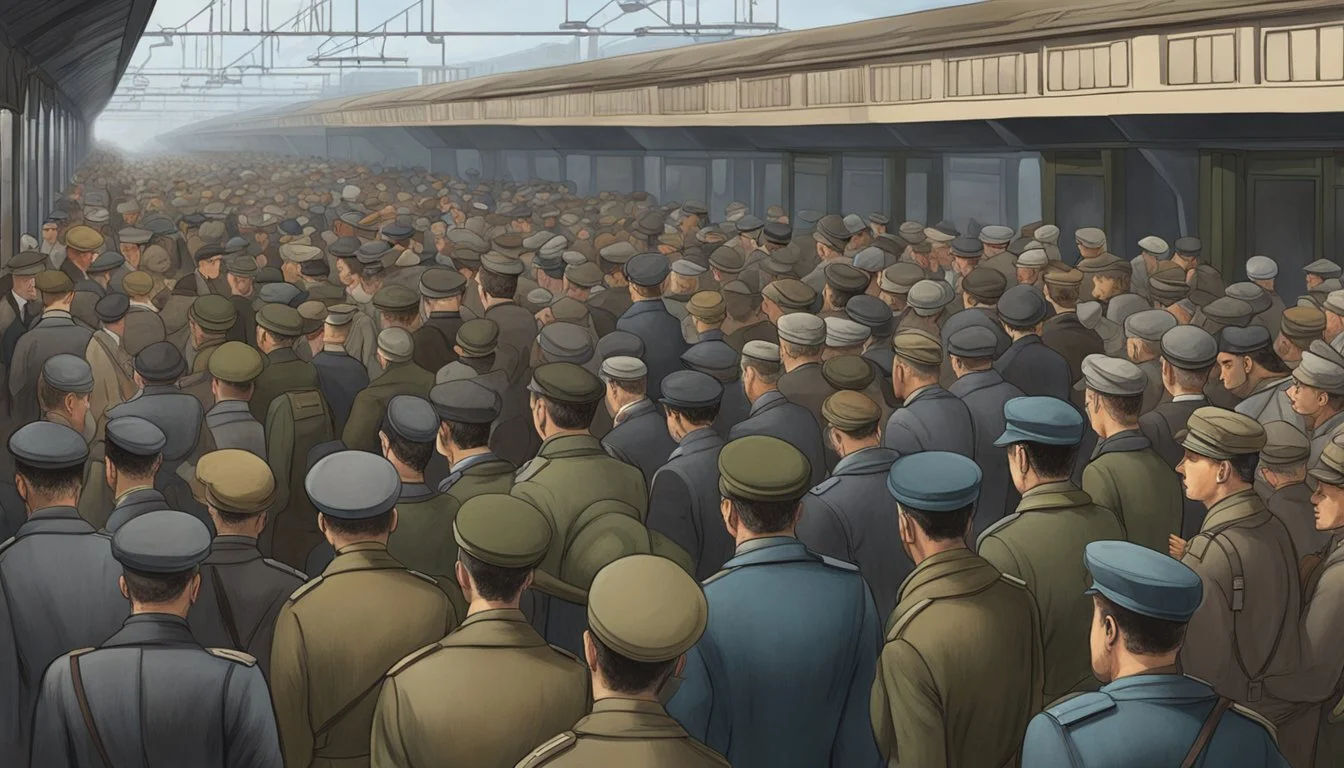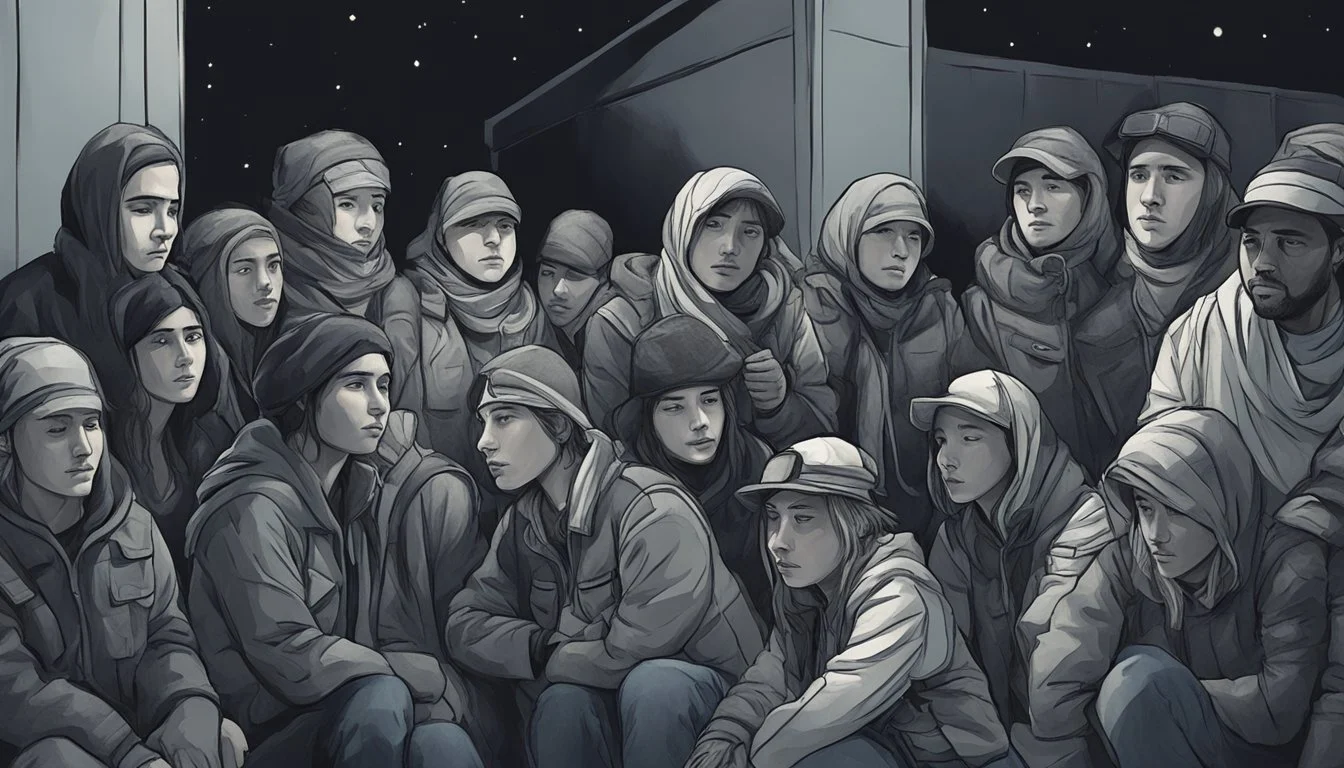Defying the Nazis: The True Story of Schindler's List
A Holocaust Hero's Legacy
"Schindler's List" tells the extraordinary true story of Oskar Schindler, a German businessman who saved over 1,000 Jewish lives during the Holocaust. Set against the backdrop of Nazi-occupied Poland, the film depicts Schindler's transformation from an opportunistic war profiteer to a compassionate savior.
Oskar Schindler exploited the Nazi regime's policies for cheap labor but ultimately risked his life and fortune to protect his Jewish workers from deportation and death. His factory in Krakow became a sanctuary for Jews, shielding them from the horrors of concentration camps like Auschwitz.
Steven Spielberg's 1993 film adaptation brought this powerful story to a global audience, shedding light on a lesser-known hero of World War II. The movie's unflinching portrayal of Nazi atrocities, including the liquidation of the Krakow ghetto, serves as a stark reminder of the Holocaust's brutality and the courage of those who resisted it.
Origins of 'Schindler's List'
The story of Oskar Schindler's heroic efforts to save Jewish lives during the Holocaust first gained widespread attention through Thomas Keneally's 1982 book "Schindler's Ark."
Keneally, an Australian novelist, learned about Schindler's remarkable actions from Leopold Page, a Holocaust survivor who had been saved by Schindler. This chance encounter inspired Keneally to write a novel based on Schindler's life.
The book quickly garnered critical acclaim and won the Booker Prize. Its success caught the attention of Hollywood, particularly Steven Spielberg, who acquired the film rights.
Spielberg was deeply moved by Schindler's story and saw it as an opportunity to create a powerful cinematic depiction of the Holocaust. He enlisted Steven Zaillian to adapt Keneally's book into a screenplay.
The film's development took over a decade, as Spielberg felt he needed to mature as a filmmaker before tackling such a weighty subject. He also wanted to ensure the story was told with the utmost respect and accuracy.
In 1993, Spielberg finally brought "Schindler's List" to the screen. The film starred Liam Neeson as Oskar Schindler and was shot in black and white to evoke the documentary-like feel of historical footage.
Oskar Schindler: The Man Behind the Legend
Oskar Schindler's transformation from Nazi Party member to savior of over 1,000 Jews is a tale of moral awakening. His journey exemplifies how individuals can choose compassion even in the darkest times.
Early Life and Joining the Nazi Party
Born in 1908 in Austria-Hungary, Oskar Schindler grew up in a Catholic family. As a young man, he worked various jobs and married Emilie Pelzl in 1928. Schindler's business acumen and charm served him well in his early career.
In 1935, he joined the Nazi Party. This decision was likely motivated by opportunism rather than ideology. Schindler saw party membership as a way to advance his business interests.
His connections with the Abwehr, German military intelligence, further positioned him for future opportunities.
Transition to War-Time Opportunist
When Germany invaded Poland in 1939, Schindler moved to Krakow. He acquired an enamelware factory that had been confiscated from Jewish owners. Initially, Schindler's motivations were purely financial.
He employed Jewish workers because they were cheap labor. The factory produced cookware and, later, munitions for the German military. Schindler's charm and bribes helped him navigate Nazi bureaucracy.
His lifestyle during this period was extravagant, marked by heavy drinking and numerous affairs.
Journey from Profit-Seeker to Rescuer
Schindler's transformation began as he witnessed the brutality of the Nazi regime. The liquidation of the Krakow ghetto in 1943 deeply affected him. He started using his influence and wealth to protect his Jewish workers.
Schindler bribed Nazi officials to keep his workers from being deported to death camps. He falsified records, claiming unskilled workers were essential skilled laborers. When his factory was moved to Czechoslovakia, he negotiated to bring his workers with him.
By the war's end, Schindler had spent his entire fortune on bribes and black-market supplies to save his workers. His efforts ultimately rescued over 1,000 Jews from almost certain death.
The Enactment of the Final Solution
The Nazi regime's "Final Solution" marked the systematic genocide of European Jews during World War II. This horrific campaign stemmed from deeply rooted antisemitic ideology and was implemented through an intricate network of death camps and mass killings.
Nazi Ideology and the Jewish Question
Nazi racial theory positioned "Aryans" as superior and Jews as an existential threat. Hitler's writings and speeches consistently scapegoated Jews for Germany's problems. The Nuremberg Laws of 1935 codified discrimination, stripping Jews of citizenship and basic rights.
Propaganda portrayed Jews as subhuman and dangerous. Public humiliation, boycotts of Jewish businesses, and segregation became commonplace. The Kristallnacht pogrom in 1938 marked an escalation of violence.
Initially, forced emigration was the Nazi "solution." But as German conquests expanded, millions of Jews came under Nazi control. More radical measures were deemed necessary by Nazi leadership.
Implementation of Genocide
The invasion of the Soviet Union in 1941 saw mobile killing units called Einsatzgruppen follow the army, conducting mass shootings of Jews. Over 1 million were murdered this way.
The Wannsee Conference in January 1942 coordinated the "Final Solution" across occupied Europe. A network of death camps was established in Poland, including Auschwitz-Birkenau, Treblinka, and Sobibor.
Jews were deported en masse to these camps. Most were gassed upon arrival. Others endured slave labor, starvation, and medical experiments. By 1945, approximately 6 million European Jews had been murdered.
Schindler's Factory: A Haven in Hell
Oskar Schindler's enamelware factory in Krakow became a lifeline for Jewish workers during the Holocaust. The facility provided a shield from the brutality of Nazi concentration camps and gave hope to those employed there.
The Creation of the Emalia Factory
Schindler acquired the Emalia factory in 1939, shortly after Germany's invasion of Poland. The facility, formerly owned by Jewish businessmen, produced cookware for the German military. Schindler's initial motivation was profit, but he soon recognized the opportunity to protect Jewish workers.
He strategically employed Jewish forced laborers, arguing their skills were essential for production. This decision allowed him to keep workers away from deportation to death camps.
Schindler bribed Nazi officials to maintain control over his workforce. He gradually expanded the factory's operations, creating more positions to save additional lives.
Conditions for Workers and the Jewish People
Emalia offered significantly better conditions than Nazi-run camps or ghettos. Workers received larger food rations and had access to basic medical care. Schindler ensured humane treatment, prohibiting physical abuse by guards.
The factory became a safe haven where Jewish workers could practice their faith discreetly. Schindler often warned his employees of impending SS raids, allowing them to hide religious items.
He set up a subcamp at the factory for workers to live on-site, further protecting them from Nazi roundups. This arrangement helped families stay together, a rare occurrence during the Holocaust.
Schindler's efforts ultimately saved approximately 1,200 Jews from almost certain death in extermination camps.
The Schindlerjuden: The Lives Saved
Oskar Schindler's efforts to protect Jewish workers resulted in over 1,100 people being spared from Nazi concentration camps. These survivors, known as the Schindlerjuden, faced numerous challenges during and after World War II.
Compilation of Schindler's List
Oskar Schindler carefully curated his list of Jewish workers, prioritizing those most vulnerable to Nazi persecution. He included skilled laborers, families, and individuals recommended by Jewish leaders. The list evolved over time, with names added and removed based on various factors.
Schindler negotiated with Nazi officials to keep his workers, often using bribes and leveraging his connections. He convinced authorities that his Jewish employees were essential for war production, thereby protecting them from deportation.
The final list contained approximately 1,100 names. It included men, women, and children from diverse backgrounds, united by their shared status as Schindler's protected workers.
The Fate of the Schindlerjuden during and after the War
During the war, the Schindlerjuden worked in Schindler's factories, enduring harsh conditions but avoiding the deadly fate of concentration camps. Schindler provided them with additional food and medical care when possible.
As the war neared its end, Schindler orchestrated the relocation of his workers to Czechoslovakia, saving them from potential last-minute Nazi atrocities. After liberation, many Schindlerjuden faced the challenge of rebuilding their lives in a post-war world.
Some emigrated to Israel, the United States, or other countries, while others remained in Europe. The Schindlerjuden and their descendants have played a crucial role in preserving Oskar Schindler's legacy, sharing their stories and honoring his memory.
The Legacy of Schindler's Actions
Oskar Schindler's efforts to save Jewish lives during the Holocaust had far-reaching consequences that extended well beyond World War II. His actions inspired global recognition and reshaped narratives surrounding the Holocaust.
Recognition and Commemoration
Oskar Schindler received numerous posthumous honors for his heroic deeds. In 1963, Yad Vashem recognized him as "Righteous Among the Nations," a title bestowed upon non-Jews who risked their lives to save Jews during the Holocaust.
Schindler's grave in Jerusalem became a pilgrimage site. Visitors often leave stones on his tombstone, a Jewish tradition to honor the deceased.
The Oskar Schindler Factory in Kraków, Poland, now houses a museum dedicated to his life and the experiences of Kraków's Jews during World War II.
Several countries have issued postage stamps featuring Schindler's image, further cementing his place in public memory.
Influence on Holocaust Narratives
Schindler's story significantly impacted how the Holocaust is remembered and discussed. The 1993 film "Schindler's List" brought his actions to a global audience, sparking renewed interest in individual acts of courage during the Holocaust.
The film's success led to increased funding for Holocaust education programs worldwide. It also inspired other filmmakers to explore lesser-known stories of rescue and resistance during this period.
Schindler's tale highlighted the complex moral choices individuals faced under Nazi rule. It challenged simplistic notions of good and evil, showing that even those affiliated with the Nazi party could choose to act humanely.
His story became a powerful example used in ethics courses to discuss moral decision-making in extreme circumstances.
Adaptations and Cultural Impact
Oskar Schindler's story of saving over 1,000 Jews during the Holocaust has been adapted into influential works of literature and film. These adaptations have played a crucial role in shaping public understanding of this historical event and its moral implications.
Thomas Keneally's Novel 'Schindler's Ark'
Australian author Thomas Keneally published 'Schindler's Ark' in 1982. The book won the Booker Prize for fiction that year. Keneally based his work on interviews with Schindler's List survivors and extensive research.
The novel blends historical facts with narrative storytelling. It presents Oskar Schindler as a complex character - a Nazi Party member who becomes an unlikely savior.
'Schindler's Ark' brought the story to international attention. It laid the groundwork for further adaptations and sparked renewed interest in Schindler's actions during the war.
Steven Spielberg's Film 'Schindler's List'
Steven Spielberg's 1993 film adaptation, 'Schindler's List', dramatically increased public awareness of Schindler's story. The movie starred Liam Neeson as Oskar Schindler and Ben Kingsley as Itzhak Stern.
Shot primarily in black and white, the film employed stark visuals to convey the horror of the Holocaust. Spielberg's direction emphasized emotional impact while maintaining historical accuracy.
'Schindler's List' was a critical and commercial success. It won seven Academy Awards, including Best Picture and Best Director. The film's reach extended far beyond cinema, becoming a cultural touchstone.
Public Reception and Educational Role
'Schindler's List' had a profound impact on public consciousness. It brought the Holocaust into mainstream discourse and sparked discussions about morality and heroism during wartime.
Many schools incorporated the film into their curricula. It became a tool for teaching about the Holocaust and its human impact. The Shoah Foundation, established by Spielberg, used the film's proceeds to record testimonies from Holocaust survivors.
Critics praised the film's emotional power but also debated its portrayal of complex historical events. Some questioned whether a Hollywood production could adequately represent such a tragic period.
The film's legacy continues today. It remains a significant work in Holocaust education and remembrance, influencing how new generations understand this critical historical period.
Historical Accuracy and Artistic License
Steven Spielberg's "Schindler's List" blends historical facts with cinematic storytelling. The film's portrayal of Oskar Schindler and the Holocaust has sparked discussions about its adherence to historical events and its artistic interpretations.
Critiques of Factual Deviations
The movie takes some liberties with historical details. Schindler's initial motivations for employing Jews are simplified, focusing more on profit than the gradual evolution of his sympathies. The film condenses the timeline of events, merging multiple Nazi officials into composite characters for narrative clarity.
Some scenes, like the infamous "shower scene," are dramatized for emotional impact. While such moments didn't occur exactly as depicted, they represent broader truths about Holocaust experiences.
Historians note that the film overemphasizes Schindler's role in creating "the list," which was actually compiled primarily by his Jewish accountant, Itzhak Stern.
Debate on the Portrayal of Schindler
Spielberg's depiction of Oskar Schindler has been both praised and criticized. The film presents Schindler as a more straightforward hero than historical accounts suggest. His transformation from opportunist to savior is accelerated for dramatic effect.
Some argue that the movie downplays Schindler's flaws, such as his womanizing and drinking. Others contend that this simplification was necessary to convey the essence of his heroic actions.
The film's impact on public perception is significant. It popularized Schindler's story, leading to increased recognition of his efforts. This portrayal has become the dominant narrative about Schindler in popular culture.
Contemporary Relevance and Education
"Schindler's List" continues to play a vital role in educating people about the Holocaust and combating modern anti-Semitism. The film serves as a powerful tool for remembrance and historical understanding.
Holocaust Education and Remembrance
"Schindler's List" is widely used in schools and universities as an educational resource. The film provides a visceral portrayal of the Holocaust, making history tangible for younger generations. Many educators incorporate the movie into their curriculum to teach about the dangers of prejudice and the importance of moral courage.
The Shoah Foundation, established by Steven Spielberg after making the film, has collected over 55,000 testimonies from Holocaust survivors. This vast archive serves as an invaluable resource for researchers, students, and the public.
Museums and memorial sites often screen "Schindler's List" or use clips to enhance visitor experiences. The film's impact extends beyond the classroom, reaching a broad audience and fostering dialogue about genocide prevention.
Modern Anti-Semitism and the Importance of Historical Memory
"Schindler's List" remains relevant in addressing contemporary anti-Semitism. The film reminds viewers of the extreme consequences of unchecked hatred and discrimination. It serves as a cautionary tale against the resurgence of anti-Semitic attitudes and actions in various parts of the world.
The movie emphasizes the importance of preserving historical memory. By depicting the horrors of the Holocaust, it challenges denial and minimization of this tragic event. "Schindler's List" encourages viewers to recognize and confront present-day manifestations of prejudice and intolerance.
Many organizations use the film as a starting point for discussions about human rights and social justice. It inspires activism and promotes the idea that individual actions can make a significant difference in combating hatred and protecting vulnerable populations.
Conclusion
"Schindler's List" stands as a powerful testament to human courage in the face of unimaginable evil. Oskar Schindler's actions saved over 1,000 Jewish lives during the Holocaust.
The film's impact extends far beyond the silver screen. It sparked important conversations about the Holocaust and brought this dark chapter of history to mainstream attention.
Steven Spielberg's masterful direction created an unforgettable cinematic experience. The stark black-and-white imagery and haunting score underscore the gravity of the subject matter.
Thirty years after its release, "Schindler's List" remains a vital work. It continues to educate new generations about the horrors of the Nazi regime and the importance of standing up against injustice.
The film's enduring legacy serves as a reminder of the power of individual action. Oskar Schindler's story demonstrates how one person can make a profound difference, even in the darkest of times.
"Schindler's List" is more than just a movie - it's a call to moral courage and compassion. Its message of hope amidst despair continues to resonate with audiences worldwide.







